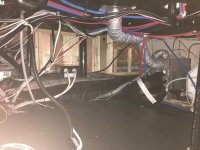JPaulChase
Member
How is the basement normally heated by a propane furnace? I have a 2013 Big Country 2950 RK that I recently purchased.
Is it normal to just let a 2 inch diameter flexible duct hose drop down into the water heater area? The furnace has three - 4 inch diameter flexible ducts running to various parts of the 5th wheel. But this 2 inch duct is about 3 foot long and just hangs down from the furnace and is pointed toward the water heater. Due to the cluster of pipes in the road I can not determine if this 2 inch duct fell off a connection or was intentionally installed that way.
Sorry I can't post a picture for your review. I am a new kid on the block without attachment rights.
Paul Chase
Ol' Man at the Sea
Ocean Shores, WA
Is it normal to just let a 2 inch diameter flexible duct hose drop down into the water heater area? The furnace has three - 4 inch diameter flexible ducts running to various parts of the 5th wheel. But this 2 inch duct is about 3 foot long and just hangs down from the furnace and is pointed toward the water heater. Due to the cluster of pipes in the road I can not determine if this 2 inch duct fell off a connection or was intentionally installed that way.
Sorry I can't post a picture for your review. I am a new kid on the block without attachment rights.
Paul Chase
Ol' Man at the Sea
Ocean Shores, WA

